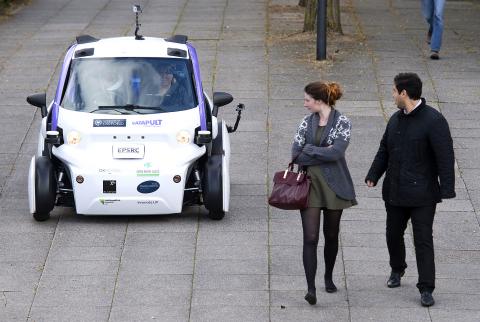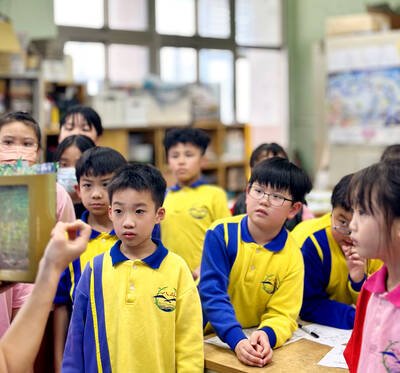In certain sunny climes, self-driving cars are multiplying. Dressed in signature spinning sensors, the vehicles putter along roads in California, Arizona and Nevada, hoovering up data that will one day make them smart enough to run without humans.
Besides perennial sunshine, those places share other common traits: wide, well-manicured roads, functional traffic enforcement, and agreeable local governments. That’s how Chandler, Arizona — a Phoenix suburb on nobody’s radar as of a few weeks ago — became the first US town to host autonomous cars on public streets without human safety drivers. Courtesy of Waymo, they’re expected to start carrying passengers within the next few months.
If you ask many Silicon Valley companies, the future of driverless cars is just a couple of years away. But halfway across the world, the outlook is a lot more skeptical.

Photo: AP
“We don’t have the luxury of California roads,” says Olga Uskova of Cognitive Technologies, a Russian software maker that specializes in autonomous vehicles. “The environment is ever-changing: the snow has covered traffic signs; it’s raining on your windshield, the sun is blocking you. Our people train using these kinds of data.”
BAD TRAFFIC
Uskova asserts that technology tested in sun-drenched utopias can’t possibly translate to a city like Moscow. Gnarly road planning, terrible weather and reckless habits make the Russian capital one of the worst cities in the world for drivers.

Photo: AFP
With roads that spread like a cobweb away from the Kremlin, disturbances like car wrecks, construction and government motorcades can wreak havoc for miles. Seat belts are scorned, and traffic laws widely ignored; speeding violations are enforced with US$4 fines, paid by phone. It’s no surprise that Russia’s rate of road fatalities is nearly double that of the US, with an average of 20 serious accidents a day just in Moscow.
Or, for that matter, that dashcam videos of Russian road fights and collisions make up such a popular subgenre on YouTube.
But most of the world’s roads look more like Russia than Mountain View, and according to Uskova, that gives Russian developers an edge in building the brains of autonomous cars.

Photo: AP
That theory was tested at a recent event in Moscow, advertised as the world’s first hackathon for driverless cars. In an austere, Soviet-era dormitory, top engineering students from far-flung schools like MIT, Cambridge and Peking University sank into beanbag chairs for a three-day coding binge.
“We’re here because it’s a chance to change the world over the next 10 to 15 years,” said Mitch Mueller, a student who traveled from the University of Wisconsin to compete. They were also competing for a cash prize, bragging rights and — most importantly — the attention of participating companies, including Uber and Nvidia, eager to recruit the next generation of AI talent.
MIMICKING THE BRAIN
The event had another purpose: to advance a credo that when it comes to autonomous cars, tougher conditions produce smarter technology. Lidar — the expensive, light-pulsing sensors relied upon by current autonomous car models — is worthless in snow and thus “a fake,” says Uskova. Instead, cars should be trained to operate using high-definition cameras, low-cost radars and powerful AI that mimics the human brain.
As the 150 engineers pored over Moscow road data, it was obvious that this vision is a long ways off. Most cars struggled to identify signs, for instance, which were hard to detect in snow or rain; and for non-Russian speakers, the task was practically impossible.
“The problem is that the signs are small, and in Russia they look very similar,” explained Sami Mian, a computer scientist at Arizona State University. “The main difference is numbers and arrows, and a city entry sign can look almost the same as a stop sign. The top team had 40 percent accuracy.”
That team, three local guys from Moscow, had tapped into a secret weapon: a trove of the popular dashcam footage, which had been harvested and stored at nearby Moscow State University. Derived from 100,000 dashcam videos, that data served as the building blocks of a basic neural network hammered out by the cigarette-puffing coders, who mentioned that they had slept a total of five hours over three days.
Russian-built autonomous systems are already in use by Kamaz, Russia’s largest truck maker, and an agricultural equipment company. Both are working with Cognitive Technologies to build autonomous machines. But adapting the technology for city use, and bringing it to the international stage, is a steep battle.
No government agency has developed regulations for autonomous cars, so road testing is constrained to designated testing zones. The only car testing zone in Moscow is a 400-meter track embellished with pedestrian crossings, road signs, markings and a section with circular traffic.
It’s a lousy facsimile of Moscow roads, or any road. But even worse is its location far outside the city center: a planned ride-along was scrapped because of bad traffic.

May 26 to June 1 When the Qing Dynasty first took control over many parts of Taiwan in 1684, it roughly continued the Kingdom of Tungning’s administrative borders (see below), setting up one prefecture and three counties. The actual area of control covered today’s Chiayi, Tainan and Kaohsiung. The administrative center was in Taiwan Prefecture, in today’s Tainan. But as Han settlement expanded and due to rebellions and other international incidents, the administrative units became more complex. By the time Taiwan became a province of the Qing in 1887, there were three prefectures, eleven counties, three subprefectures and one directly-administered prefecture, with

It’s an enormous dome of colorful glass, something between the Sistine Chapel and a Marc Chagall fresco. And yet, it’s just a subway station. Formosa Boulevard is the heart of Kaohsiung’s mass transit system. In metro terms, it’s modest: the only transfer station in a network with just two lines. But it’s a landmark nonetheless: a civic space that serves as much more than a point of transit. On a hot Sunday, the corridors and vast halls are filled with a market selling everything from second-hand clothes to toys and house decorations. It’s just one of the many events the station hosts,

Through art and storytelling, La Benida Hui empowers children to become environmental heroes, using everything from SpongeBob to microorganisms to reimagine their relationship with nature. “I tell the students that they have superpowers. It needs to be emphasized that their choices can make a difference,” says Hui, an environmental artist and education specialist. For her second year as Badou Elementary’s artist in residence, Hui leads creative lessons on environmental protection, where students reflect on their relationship with nature and transform beach waste into artworks. Standing in lush green hills overlooking the ocean with land extending into the intertidal zone, the school in Keelung

Taiwan Power Co (Taipower, 台電) and the New Taipei City Government in May last year agreed to allow the activation of a spent fuel storage facility for the Jinshan Nuclear Power Plant in Shihmen District (石門). The deal ended eleven years of legal wrangling. According to the Taipower announcement, the city government engaged in repeated delays, failing to approve water and soil conservation plans. Taipower said at the time that plans for another dry storage facility for the Guosheng Nuclear Power Plant in New Taipei City’s Wanli District (萬里) remained stuck in legal limbo. Later that year an agreement was reached